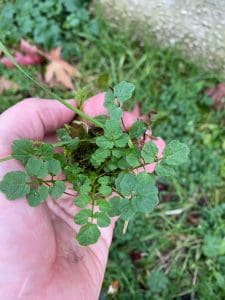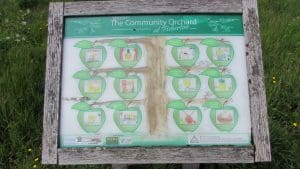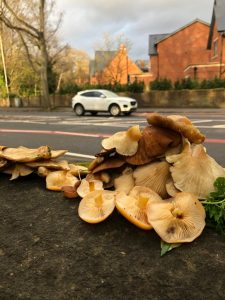In this blog I’d like to highlight what to forage in an urban environment, looking at a few common species of edible plants and fungi that you might find in any urban or built up areas in the UK. There are actually a huge variety to look for, from the hardy and adaptable ‘weeds’ that just grow where they want, to things deliberately cultivated by people in parks and gardens. Some species are just as common in the countryside and have been used for food for centuries, while others might be more unusual introduced species that you would only find if a person had brought them in on purpose and carefully looked after them. And yet others have started out as garden plants but then enjoyed themselves a little too much and gone invasive – in which case foraging them to eat is actually helping maintain them in balance with other plants for greater biodiversity.
I’ve divided these up into some different types of habitat, but to be honest many of these plants are tough and adaptable and will grow just about anywhere. One of the major joys of urban foraging is seeing how determinedly life finds a way!
Pavement/hard landscaping:
Hairy Bittercress and Herb Robert, grow readily in cracks in the concrete or in even the tiniest pockets of poor dusty soil. Broad-leaved plantain can handle heavy trampling so comes into its own in places with heavy footfall.

Public park/ sports fields – short grass:
Plants that can handle bright sunlight and frequent mowing might be small, but they hold their own in patches amongst the grass. Clover, Daisy, Dandelion, Pineapple weed, Yarrow, Broadleaved and Ribwort plantains all go well in a salad. If you need bigger leaves, look in longer grass, perhaps round the edges of the space. As for fungi, you could potentially find any grassland species, for instance Giant puffballs, Shaggy Ink caps, Agaricus species such as Horse Mushrooms or Field mushrooms. You might occasionally find quite rare species in old parts of town where the ground isn’t dug over often or has been kept undisturbed by agriculture for a few centuries – for example graveyards and parkland around stately homes sometimes support colourful Waxcaps

Long grass:
Cow Parsley, Hogweed, Yarrow, Ribwort plantain, Chamomile (especially in deliberately planted wildflower areas),

Gardens/ ornamental planting:
You might find these shrubs and trees freely accessible in a park, or hanging over a garden wall, or spreading onto waste ground or open areas from the first two!

By Richard Avery – Own work, CC BY-SA 4.0, https://commons.wikimedia.org/w/index.php?curid=79112451
It’s important not to damage the plants too much especially if it’s on public property, so please only harvest a small amount from each individual plant. It is legal to pick from branches that overhang a public right of way, but it’s absolutely not legal to cross the boundary into somebody’s garden – and if you are asked to stop or leave, you should do so immediately. Please don’t be the reason that No Foraging signs go up everywhere!
Some park and garden favourites include trees and shrubs such as Ornamental Cherry, Magnolia, Stags Horn Sumac, Rowan, Apple, Hawthorn, Sea Buckthorn, Black Elder, Whitebeam and Mahonia. Pansy, Fuschia. Honey Fungus is notorious for attacking ornamental fruit trees – bad news for gardeners but potential dinner for you.

By Ввласенко – Own work, CC BY-SA 3.0, https://commons.wikimedia.org/w/index.php?curid=76836864
Hedges and boundaries:
Hawthorn, Blackthorn /Damson, Oak, Ash, Elder. Long Grass species at the base. Invasive Himalayan balsam spreads rapidly anywhere that is hard to mow or strim

By M J Richardson, CC BY-SA 2.0, https://commons.wikimedia.org/w/index.php?curid=14158506
Waste ground, cycleways, canals, old railways –
Birch and Elder are usually the first pioneer trees, their seeds blown in on the wind in the case of Birch and dropped in bird poo in the case of Elder. Hawthorn is another bird favourite, and isn’t far behind, though it’s much slower growing. Stags horn sumac spreads in clumps from gardens and ornamental planting. Nettles and Brambles, Rosebay Willowherb and Wild Raspberry can form big patches within a few years. Giant Hogweed is both a serious safety concern, but also technically edible if handled with care. Personally, I wouldn’t risk it! It can grow anywhere, but particularly likes damper ground like rivers and canals. Himalayan balsam also likes damp areas and is extremely invasive, so whatever you can harvest will make space for more biodiversity. Fungi such as Oyster mushrooms and Chicken of the woods may appear on mature trees, Jelly Ear colonises Elder, and Birch Polypore will be specifically on Birch. Fly Agarics and Bay boletes have mycorhizal relationships around young trees.
Secondary Woodland:
If land is left alone long enough, those wasteland coloniser plants and trees will start to become new woodland. It takes a while to build up biodiversity, but whether it’s been planted deliberately by people or just developed by itself on a piece of derelict land, more species will arrive. You can expect any or all of the Hedgerow and waste ground species, with long grass species round the edges. In addition, look for mature Sycamore and Ash which often become dominant due to their prolific seeds. The longer the trees have been there, the greater fungal diversity will appear, forming mycorhizal relationships with the tree roots and breaking down the leaf litter and dead wood. You can hope to see Puffballs, Blushers, Shaggy ink caps, Common Ink caps, Agaricus species at ground level; Oyster mushrooms, Velvet Shanks and Chicken of the Woods on older trees. Clustered Domecap can be found on disturbed ground, If the woodland is very damp and dominated by willow, you may find patches of Scarlet Elf Cups, a colourful winter treat. Invasive 3 Corner Leek and other allium species such as Wild Garlic will start to spread if introduced.

Ancient Woodland:
it might seem crazy, but you honestly might be lucky enough to stumble on a tiny sliver of ancient woodland species even in a very built up area. What is crucial for these species survival is that the soil has remained largely undisturbed for over 400 years, and that there has been some continuous tree cover even if the individual trees aren’t that old. Typically it will be a small strip along the boundary of a wood that used to be much bigger, but where the boundary has remained in place even after the main wood has been cut down. Or a patch of land too steep or awkward or boggy to have ever been ploughed or built on – so steep sided cloughs or gullies are well worth a look. Wild Garlic is a nice edible clue, as it hates ground disturbance, as do English Bluebells ( though if hybridised with the invasive Spanish bluebells this muddies the evidence a little bit). The definitive list of Ancient Woodland Indicator species would vary according to where you are – some are so rare now that they have a very limited range. This page can give some examples . In terms of foraging, as long as it’s a big healthy patch you don’t need to feel bad about taking a few leaves of Wild Garlic. However if you think you may have stumbled on some of these other rare and precious species, please don’t damage them – the site should probably be protected and your local Wildlife Trust may be able to advise further.
Local people advocating for green spaces and proving that they are useful and valued by the community is a powerful force for making sure those spaces stay accessible and those plant and fungi species are protected. Urban areas are often overlooked in terms of their conservation value, but the more you tune in and look around the more likely you are to discover something really interesting and special, as well as find good patches to pick up a free and sustainable lunch. So what are you waiting for? Wherever you live, there is bound to be something good just round the corner from your home.
Check out our courses in an Urban area near you to get some hands on experience – We’re sure you’ll be looking at the concrete jungle in a whole new light in no time.





